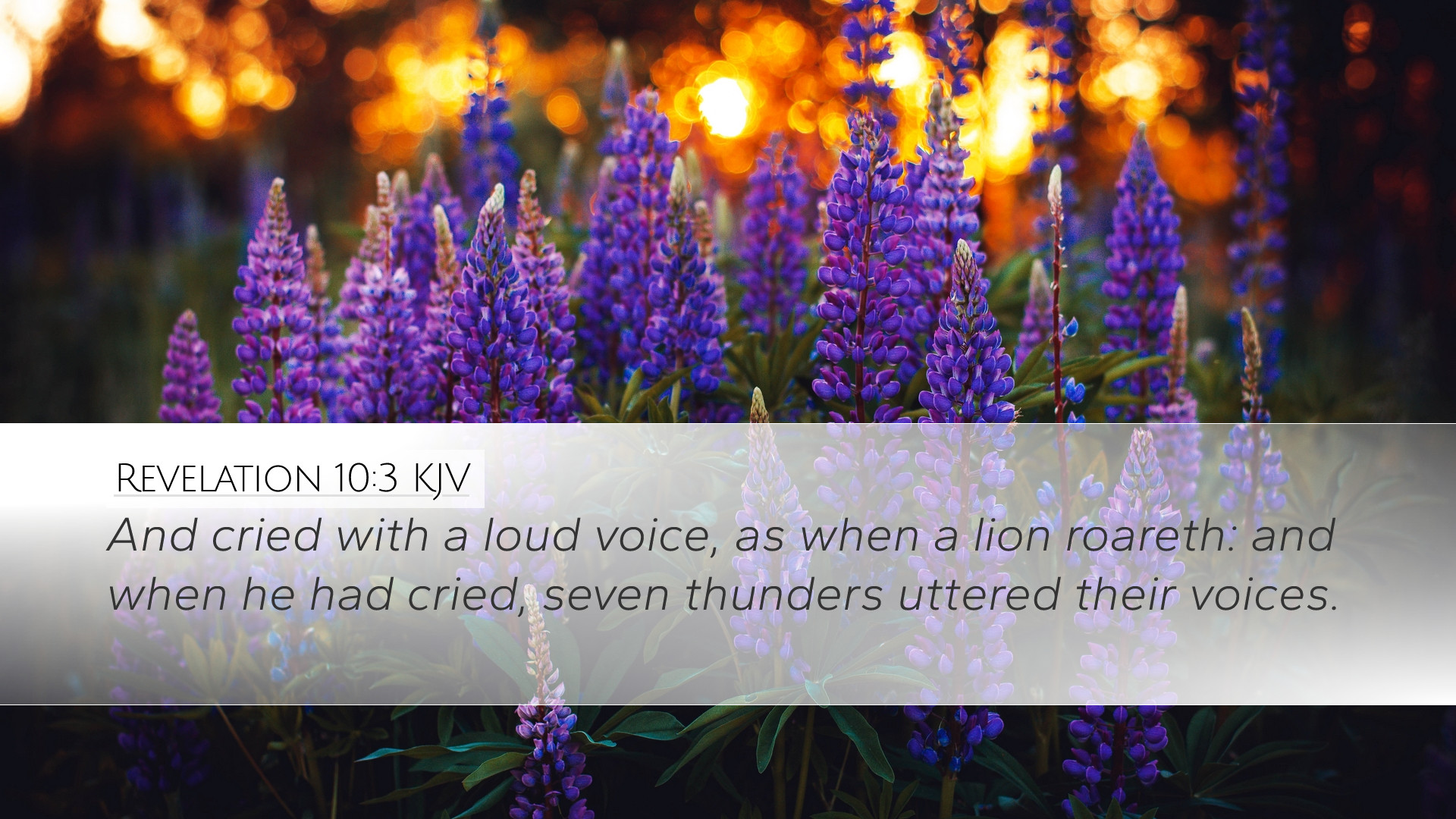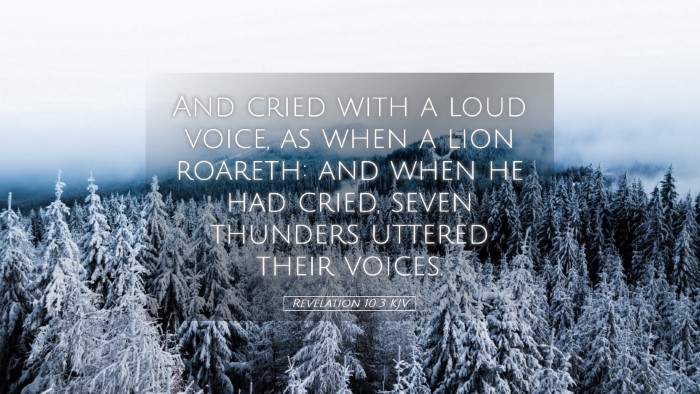Commentary on Revelation 10:3
Bible Verse: "And cried with a loud voice, as when a lion roareth: and when he had cried, seven thunders uttered their voices." (Revelation 10:3)
Introduction
The book of Revelation is filled with symbolic language and apocalyptic imagery, aiming to convey profound spiritual truths. Revelation 10:3 is a pivotal verse, and its imagery of the mighty angel’s proclamation serves as a gateway to understanding God's unfolding plan during the eschatological times. Here, we combine insights from Matthew Henry, Albert Barnes, and Adam Clarke to provide a comprehensive commentary for pastors, students, and theologians.
The Mighty Angel
This verse introduces a mighty angel, depicted as having a loud voice akin to that of a roaring lion. The presence of this angel speaks profoundly about God's authority and the gravity of the message being delivered. According to Matthew Henry, this angel's attributes symbolize strength and majesty, suggesting that this message will have significant weight in the prophetic narrative.
Symbolism of the Lion
The roar of a lion is a symbol of strength and ferocity, often representing God’s power and judgment. Adam Clarke emphasizes that the lion’s roar is indicative of the seriousness of divine communication. It reflects the urgency and magnitude of what is to be revealed, calling attention to both the solemnity and the significance of the message about to be proclaimed.
The Seven Thunders
In response to the angel's cry, seven thunders utter their voices. The number seven is frequently used in the Bible to denote completeness or perfection, which suggests that the messages from these thunders are complete in their revelation. Albert Barnes elucidates that the thunders symbolize the voice of God, which is often associated with judgment and divine authority.
Interpretations of the Thunders
The content of what the seven thunders said is not revealed, creating an air of mystery that has intrigued scholars throughout the centuries.
- Addison: Some interpret the silence surrounding the thunders as a reminder that not all divine revelations are meant for immediate understanding or disclosure.
- Henry: Others suggest that their silence emphasizes the idea that God's plans are not always fully disclosed to humanity but remain part of the divine mystery.
- Clarke: He intimate that the contents might be too sacred or significant for mere human comprehension, foreshadowing the greater things yet to be revealed in the prophecy.
Theological Implications
This passage underscores several theological themes that are essential for understanding the book of Revelation as a whole:
- God's Sovereignty: The mighty angel's authoritative proclamation and the response of the thunders reinforce the sovereign control God has over His creation and His redemptive plans.
- Warning and Urgency: The loud cry and the roar-like voice create a sense of urgency for believers and the world to heed the divine message, paralleling the prophets of old who proclaimed God's words with fervor.
- The Mystery of Divine Revelation: The sealed messages of the thunders remind us that God's ways are often above our understanding, and there are aspects of His plan that are withheld from humanity, urging believers to trust in His ultimate wisdom.
Practical Applications
For pastors and church leaders, Revelation 10:3 serves as a call to communicate God's Word with the fervency of a lion's roar, recognizing the weight and importance of the message being delivered. Furthermore:
- Bold Proclamation: Just as the angel cried out, believers are encouraged to proclaim the truth of the gospel boldly, not shying away from the complexities of divine revelation.
- Embrace of Mystery: Students and scholars are reminded to embrace the mystery surrounding God's plans as a means of deepening their faith and understanding of divine timelines.
- Encouragement of Prayer: Knowing that God holds complete authority reinforces the need for daily prayer, asking for wisdom and insight in comprehending His purposes.
Conclusion
In conclusion, Revelation 10:3 encapsulates a significant moment in the apocalyptic narrative with rich theological implications and practical applications. As we examine this passage through the insights of respected commentators, we are enriched in our understanding of God's majesty and the seriousness of our call to respond to His Word.
The clarification of the angelic message, juxtaposed with the mystery of the thunders, invites believers into a deeper relationship with the Almighty, encouraging an ongoing pursuit of truth as they navigate the complexities of faith in a world yearning for divine revelation.


